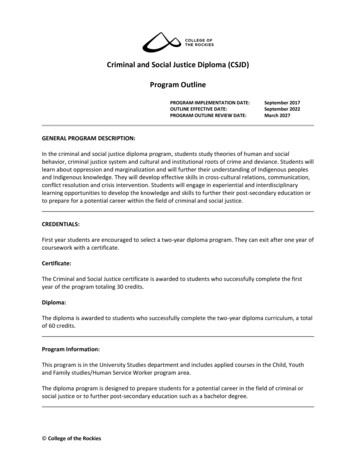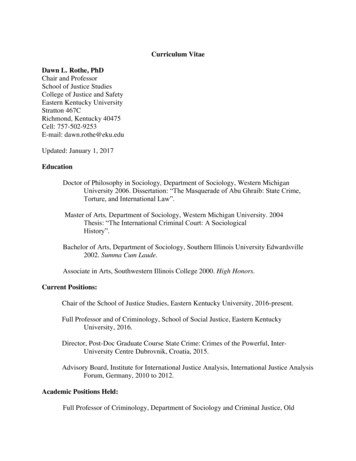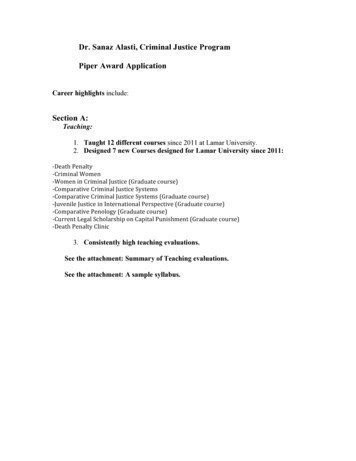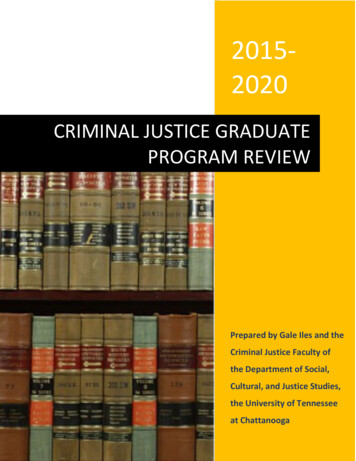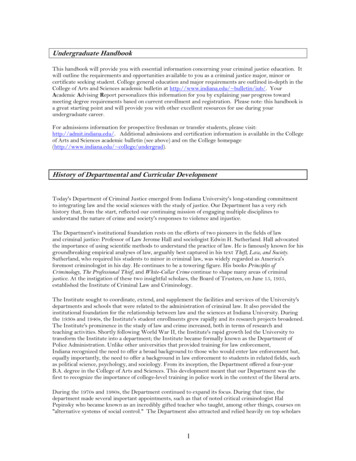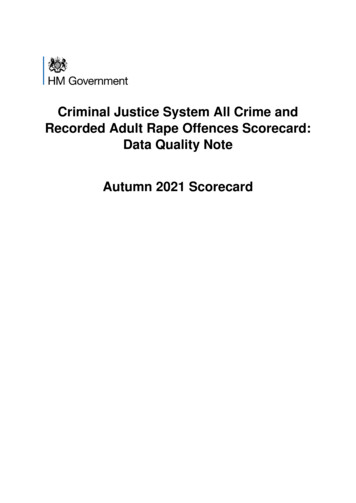
Transcription
Criminal Justice System All Crime andRecorded Adult Rape Offences Scorecard:Data Quality NoteAutumn 2021 Scorecard
IntroductionThis document outlines the different data sources used to compile the statisticspresented in the Autumn 2021 all crime and adult rape scorecard. Each section detailsany data quality considerations for each source, outlines checks completed (by systemowners and statistical processes) and flags any areas of concern. It also providesguidance for interpreting the data and in-depth definitions of the metrics detailed in thescorecard.The scorecard contains a concentrated collection of published data from a variety ofpublished sources across the Criminal Justice System, many of which are NationalStatistics releases. Further details on these, including guidance for interpreting thedata and data quality reports, can be found at the end of this document.Data sourcesHome OfficeThe data that forms the basis of the Crime Recorded to Police Decision section ofthe scorecard is produced using the official crime outcomes in England and Walesstatistics. There are three crime outcomes data sources: Aggregated Crimsec4 return: an aggregated return supplied on monthly basisfrom small number of police forces Home Office Data Hub (HODH): The HODH allows police forces to providerecord-level detail on offences. Voluntary returns: The Home Office requested that all forces providingCrimsec4, voluntarily provide additional outcomes data on a quarterly basis.The Home Office receives monthly data from police forces on crime, crime outcomesand records that were initially recorded as crimes and subsequently transferred toanother police force or cancelled. These data are quality assured and analysed byHome Office statisticians and any anomalies or errors identified through this processresult in a report being returned to the relevant force for validation or correction. Priorto the publication of crime outcomes, a verification exercise is carried out with allforces. The data held by the Home Office are returned to individual forces asking forconfirmation that the data accords with that held on their own systems and to highlightany perceived inconsistencies in their data. Again, forces resubmit data if required.The metric measuring number of median days excludes data from the following PoliceForce Areas: Greater Manchester, Kent, Staffordshire, West Midlands, and Wiltshire.These forces did not provide offence-level data to the Home Office Data Hub for thereporting period. The volume of outcomes and offences does not include GreaterManchester Police as they have not been able to supply outcomes for the reportingperiod. When the required data is provided, these will be included in future publicationsof the scorecard.
Crown Prosecution ServiceThe data that forms the basis of the Police Referral to CPS Decision to Chargesection of the scorecard is derived from the CPS Case Management System (CMS)used by CPS staff for case management purposes and its associated ManagementInformation System (MIS). As with any large-scale recording system, data is subjectto possible errors in entry and processing. The CPS does not publish official statistics.The figures are provisional and subject to change as more information is recorded bythe CPS. The data is held within a database within the MIS, based on suspects (priorto being charged) or defendants (after being charged). The scorecards include totaldata on all suspects or defendants irrespective of sex or gender.In these statistics, a suspect or defendant represents one person in a single set ofproceedings, which may involve one or more charges. A set of proceedings usuallyrelates to an incident or series of related incidents that are the subject of a police file.If a set of proceedings relates to more than one person then each is counted as asuspect or defendant. Sometimes one person is involved in several sets ofproceedings during the same year: if so, he or she is counted as a suspect ordefendant on each occasion.Ministry of JusticeThe data on the CPS Charge to Case Completion in Court is produced using therespective criminal court management information systems (MIS), data warehousingfacilities drawing data directly from court-based administrative systems. For theMagistrates’ Courts data this is LIBRA and for the Crown Court data this is XHIBIT.LIBRA and Xhibit are used by court staff for case management purposes. Thiscontains information about the incidences and dates of major events as each caseproceeds in the Crown Court. Being from an administrative system, data is subject toclerical and input errors - the volume of these errors is low and assumed to be randomacross all cases. As such they are not believed to impact on the integrity of the data.The ‘Common Platform’ is a new digital case management system for the magistrates’and Crown Courts. The system seeks to streamline data collection, data accessibilityand improve the way criminal cases are processed across the Criminal JusticeSystem. It will eventually replace the existing ‘legacy’ criminal court systems, with asingle, streamlined system. Early adopter courts across England and Wales aretesting the system before the rollout to all criminal courts.Currently metrics at this stage do not all include Common Platform data. Wherepossible, estimates have been included to ensure that volume trends are robust.Where it is omitted, the data represents a small number of cases and does not impactany published national trends in the current release. Work is ongoing with HerMajesty’s Courts and Tribunal Service (HMCTS) and partner agencies to betterunderstand the implications this system change has for the published NationalStatistics series, their uses (such as the scorecard) and the underlying methodologies.
We are committed to ensuring that these statistics remain accurate, robust andcoherent for users during the operational transition of data systems at the criminalcourts.Information on where witnesses have provided evidence via section 28 has beenobtained from the system used by court staff to schedule and manage the recordingand playback of the recorded hearings and as such covers all such hearings carriedout in the period covered by this report. As with other case management systems thedata is subject to clerical and input errors, but the volume is low and is not expectedto impact on the integrity of the data.This system does not record the offence(s) defendant(s) have been charged with, andthis have been obtained by matching this data using unique case references to Xhibit(mentioned above) to extract and identify adult rape offences. The match rateachieved was over 95% and the missing items were mainly cases held on CommonPlatform and a very small number for other reasons.Advice on using and interpreting the scorecard dataThe data within the all-crime and recorded adult rape scorecard aims to capture themajority of the Criminal Justice System through metrics that break the system downinto three key stages: crime recorded to police decision, police referral to CPS decisionto charge, and CPS charge to case completion at Court. Crimes recorded by the policeand the subsequent outcomes allocated to these crimes are captured by Home Office.A subset of these offences will be referred on to the CPS for prosecution. For someoffences the CPS must also make the charging decision before a prosecution cancommence. Ministry of Justice data then captures all cases reaching the criminal courtsystem from the point of receipt to completion. This data includes cases prosecutedby the CPS where the decision to charge was made by the police or the CPS. It alsoincludes cases prosecuted by the CPS that were not investigated by the police, andcases prosecuted by other prosecuting authorities besides the CPS. While the metricswithin the scorecard do not allow for a read-across of data for the entire CriminalJustice System, they measure performance of the priorities at each of these threedistinct stages.The 2019 baseline used in the scorecards is calculated as a mean average of the 2019calendar year, Q1-Q4 2019. Presenting a single quarterly average of 2019 datatherefore provides a robust snapshot of performance of the CJS in 2019, prior to thepandemic, without setting a comparison with specific quarters of data and provides auseful barometer for assessing more recent system performance from Q1 2021onwards. Quarterly variations in the majority of the scorecard metric data for 2019annual average figures are minimal which suggests the quarterly figures for 2019 arenot notably impacted by reporting quirks or seasonal variations.There are several key points to consider when interpreting the data in the scorecardmetrics. These considerations apply universally to all three sets of data provided bythe Home Office, CPS, and MoJ/HMCTS respectively:
Counting rulesEach department collects, collates and publishes metrics differently. The differentcounting basis relates to the operational priorities of each department, e.g., HomeOffice will count and consider all notifiable crimes recorded whereas the Ministry ofJustice counts those which reach court – which will be the subset of notifiable offencesresulting in charges, and a range of other summary offences that also result in a formalcourt case.Further information regarding the individual counting basis of each metric can be foundin 'Metric definitions' and in the supporting documentation for each published releasefound at the end of this document.Data linkageIt is not currently possible to accurately track individual offences or defendants acrossthe Criminal Justice System for the purposes of statistical reporting. As such there areno overarching cross-Criminal Justice System metrics included within the currentscorecard report. Work to better link the administrative data held across the CriminalJustice System is ongoing and is a high priority for enabling more joined up reportingand analysis of the drivers which impact the system as a whole.Timing and movement of cases through the systemAlthough each metric is reported at the same point in time, this relates to a differentpoint in the progress of a case through the Criminal Justice System. Comparisonsacross departmental measures will reflect these different stages. For example, theMoJ data will count defendants dealt with at court in a given quarterly period – thesewill result from offences recorded by the Home Office in earlier periods, and similarlyreferrals made to the CPS in earlier periods.Offence allocationThe way that offences are selected for reporting differs across the scorecard report.Although the same source list of defined offence codes is common acrossdepartments, the way that this is allocated to the underlying measures means thatcomparisons are difficult to accurately interpret. For example, the CPS will apply arape flag to a suspects case even if subsequently the rape offence is dropped or thesuspect is charged with a different offence (a sexual assault for example), whereasthe MoJ allocates the most serious offence in a case as the principal offence at thepoint of the case being received into the court system. For more information see Annex2: ts/publications/cps-vawg-report2019.pdfMetric definitionsThe below tables detail the scorecard metrics according to the Criminal Justice partnerthat collects the data and their accompanying definitions. Also indicated in these tables
is the point in the scorecard series at which individual metrics will be included. Whilethe majority are included in the Autumn 2021 publication, a small number are still indevelopment and are listed here to indicate the additional data that will be collectedfor future series of the all crime and recorded adult rape offences scorecard.Home OfficeMetrics in italics are those specific to the scorecard for recorded adult rape offences.Plain Englishmetric nameMedian days fromoffence recordedto a successfuloutcome foroffences wherethere is a specificindividual victim(a successfuloutcome is aformal - e.g. chargeor caution - orinformal - e.g.cannabis warning –police outcome)Statistical metricname(linked, wherepossible topublishedstatistics)Statistical definitionMedian days ofoffence recorded(victim) toinformal/formaloutcomeMedian days ismeasured from whenvictim-based offenceswere recorded by thepolice to when aAutumn 2021charge/ summonsoutcome wasassigned on the localforce recordmanagement system.Median days fromoffence recordedto a successfuloutcome foroffences wherethere are noMedian days ofspecific individual offence recordedvictims(state) toinformal/formal(a successfuloutcomeoutcome is aformal - e.g. chargeor caution - orinformal - e.g.cannabis warning –police outcome)Median days ismeasured from whenstate-based offenceswere recorded by thepolice to when aninformal/ formaloutcome wasassigned on the localforce recordmanagement system.Included inscorecardfromAutumn 2021
Median days fromoffence recordedto the policecharging anoffender wherethere is a specificindividual victimMedian days ofoffence recorded(victim) to chargeMedian days fromoffence recordedto the policecharging anMedian days ofoffender whereoffence recordedthere are no(state) to chargespecific individualvictimsPercentage ofinvestigationsclosed becausethe victim doesnot supportfurther policeactionNumber andpercentage ofpolice recordedoffences wherethe offender isissued with asuccessfuloutcome foroffences wherethere are specificindividual victims(a successfuloutcome is aformal - e.g. chargeor caution - orCrime outcomes victim does notsupport (%)Median days ismeasured from whenvictim-based offenceswere recorded by thepolice to when aAutumn 2021charge/ summonsedoutcome wasassigned on the localforce recordmanagement system.Median days ismeasured from whenstate-based offenceswere recorded by thepolice to when acharge/ summonsedoutcome wasassigned on the localforce recordmanagement system.Autumn 2021The volume ofoutcomes for'Evidential difficulties:Victim does notsupport action (bothAutumn 2021suspect identified andnot identified).Divided by alloutcomes assigned.Volume of victimbased offences wererecorded by thepolice where aninformal/ formaloutcome wasVolume/Proportion: assigned on the localInformal/formalforce recordoutcomes (victim)management system.Proportions havebeen calculated bydividing the informal/formal outcomecounts by the totaloutcome counts forAutumn 2021
informal - e.g.cannabis warning –police outcome)offences where thereare specific individualvictims.Number andVolume of statepercentage ofbased offences werepolice recordedrecorded by theoffences wherepolice where anthe offender isinformal/ formalissued with aoutcome wassuccessfulassigned on the localoutcome forforce recordoffences whereVolume/Proportion: management system.there are noInformal/formalspecific individual outcomes (state)Proportions havevictimsbeen calculated bydividing the informal/(a successfulformal outcome byoutcome is athe total outcomeformal - e.g. chargecounts for offencesor caution - orwhere there are noinformal - e.g.specific individualcannabis warning –victims.police outcome)Autumn 2021Volume ofInvestigationcomplete - nosuspect identifiedoutcomes for victimbased offences.Number andpercentage ofpolice recordedoffences wherethe investigationVolume/Proportion: Proportions havebeen calculated byis closed because No suspectdividing the nono suspect hasidentified (victim)suspect identifiedbeen identified foroutcome counts byoffences wherethe total outcomethere are specificcounts for offencesindividual victimswhere there arespecific individualvictims.Number andpercentage ofpolice recordedoffences whereVolume/Proportion: Volume ofInvestigationNo suspectcomplete - noidentified (state)suspect identifiedAutumn 2021Autumn 2021
the investigationis closed becauseno suspect hasbeen identified foroffences wherethere are nospecific victimsoutcomes, for statebased offences.Proportions havebeen calculated bydividing the nosuspect identifiedoutcome counts bythe total outcomecounts for offenceswhere there are nospecific individualvictims.Number ofrecorded offencesNo. of recordedwhere there areoffences (victim)specific individualvictimsVolume of victimbased offences.Autumn 2021Number ofrecorded offencesNo. of recordedwhere there areoffences (state)no specifiedvictimsVolume of statebased offences.Autumn 2021Percentage ofvictims without aphone for morethan 24 hoursTBCTBCProportion ofcases with chargeoutcomes vs. otheroutcomesassignedThe volume ofoutcomes for chargeoutcomes. Divided byall outcomesassigned vs. thevolume of alloutcomes excludingcharge outcomes,divided by alloutcomes assigned.Autumn 2021Percentage ofcases which resultin a charge (out ofall adult rapecases recorded)The below is analternative chargeratio metric. This isdifferent to the metricabove because itcalculates thepercentage of crimesAutumn 2021TBCPercentage ofcases whichresult in a charge(out of all adultrape cases withany outcomeassigned)Percentage ofcases whichresult in a charge(out of all adultrape casesrecorded)
where a decision hasbeen made tocharge, out of thetotal number ofcrimes recorded inthe same quarterlyperiod. These includeopen and completedinvestigations –investigations wherea decision has beenmade andinvestigations wherea decision has not yetbeen made.Crown Prosecution ServiceMetrics in italics are those specific to the scorecard for recorded adult rape offences.Plain Englishmetric nameMean days fromfirst police referralto CPS making thedecision toauthorise a chargeIncludedinscorecardfromStatisticalmetric nameStatistical definitionMean days frompolice referral toCPS decision tochargeThe number of calendar daysfrom the first referral by policeto the CPS making a decisionto charge. The police mayhave referred for an earlyadvice or charging decision.This metric is the total timetaken and may includemultiple CPS consultationsand time taken by the policeto complete furtherinvestigative work.Autumn2021The proportion ofconsultations completedwithin 28 calendar days.Charging pilot custody caseare excluded due to adifferent timescale of 3 hours.Autumn2021Percentage of CPSconsultationscompleted withinProportion of28 daysCPSconsultations(acompleted withinconsultation occurs28 dayswhen a CPSprosecutor hasconsidered new
information receivedfrom the policeand completes alegal review)Percentage ofprosecutions thatare stopped postcharge because avictim did notprovide evidenceor has withdrawnProportion ofprosecutionsthat are stoppedpost chargebecause a victimdid not provideevidence or haswithdrawnPercentage of CPSchargedprosecutions thatare stopped due to Proportion ofan incorrectCPS chargedcharging decision prosecutionsstopped due to(based on anan incorrectassessment by acharginglawyer, at any timedecisionduring prosecutionproceedings, thatthe chargeauthorised by theCPS was incorrect)The proportion of nonconvictions where the victimno longer supports theprosecution, does not, orrefuses to attend. When aprosecution is ongoing avictim is referred to by thelegal term complainant. Thedata presented is sourcedfrom CPS data that uses theterm complainant.Autumn2021The proportion of allprosecutions where a chargeAutumnwas authorised by the CPSthat were not convicted due to 2021an incorrect chargingdecision.Percentage ofcases whereappropriate legaldecisions aremadePercentage ofcases whereappropriate legal TBCdecisions aremadeSummer2022Percentage ofcases that meetthe national filequality standard(this relates to auniversal standardfor file quality whichis determined by theDirectors Guidanceon Charging, usedProportion ofcases that meetthe national filequality standardSpring2022TBC
by police officersand prosecutors)Number ofsuspects wherethe CPS has madea legal decision toeither: authorise acharge, advise thepolice theprosecution codehas not been met,or to make an outof court disposalVolume of precharge legaldecisionsThe volume of suspectsreferred by the police for acharging decision and theCPS have given a legaldecision. A legal decision ischarge, no further action orout of court disposalVolume ofsuspectsauthorised to becharged by theCPSThe volume of suspectsreferred by the police for acharging decision and theCPS has authorised a charge. AutumnA charge means that a first2021hearing has been registeredon CPS case managementsystem.Volume ofsuspectsfinalised aspendingresponse –furtherinvestigationDecisions recorded aspending response – furtherinvestigation (formally knownas Administrativefinalisations) are finalised inthe CPS Case ManagementSystem for administrativereasons following a requestfor further information beingsent to the investigatingauthority. These are not legaldecisions and may not be theend of the case.Autumn2021Number ofprosecutionsVolume ofwhere the decisionprosecutionswas made by thedroppedCPS to stop theprosecutionThe number of prosecutionsthat were stopped by theCPS.Autumn2021Number ofsuspects referredby the police tothe CPSThe volume of suspectsreferred by the police, asuspect is only counted onceAutumn2021Number ofsuspectsauthorised to becharged by CPSNumber ofsuspects referredby the police tothe CPS awaitingfurtherinvestigationbefore a chargingor legal decisioncan be madeVolume ofreferrals fromthe police for aAutumn2021
Number ofsuspects whereCPS have closedthe suspect’s fileon the CPS casemanagementsystem after alegal decision ismade or wherefurtherinvestigation isrequired prior to acharging decisionchargingdecisionfor either an early advice orcharging decisions.Volume offinalised prechargedecisionsThe volume of suspectsreferred by the police for acharging decision which hasbeen finalised on the CPSCase Management System.This includes legal decisionsand cases finalised asawaiting response – furtherinvestigation.Autumn2021Ministry of JusticePlain Englishmetric nameNumber ofoutstandingcases which havebeen at theCrown Court formore than 12monthsMean days fromcharge to caseStatisticalmetric nameProportion ofoutstandingcases “for trialolder than 12monthsMean days fromcharge toStatistical definitionOutstanding duration refersto the time between thereceipt of a case in aspecific Crown Court andthe end of the reportingperiod, for example countsin Q3 2020 relate to caseswhich are open as at theend of September 2020.IncludedinscorecardfromAutumn2021'For trial' cases are assignedat the point of receipt intothe Crown Court - we knowthat most of these cases willresult in the entry of a guiltyplea and that only a minoritywill require a trial.Estimated mean durations inAutumndays from a charge being2021given (prior to entering thecriminal courts) and the
completion at theCrown Courtcompletion atCrown Court(completionmeans anyoutcome, includingguilty pleas,acquittals andconvictions)Mean days fromcharge to casearriving at theCrown CourtMean days fromcase arriving atthe Crown Courtto casecompletion at theCrown Courtcompletion of the case – thisis based on the number ofdefendants in valid casesthat were disposed of in thereporting period. Valid casecounts exclude appeals,'bring backs' and'committals for breach'(sentence cases only),transfers out, cases whichhave been issued a benchwarrant and cases whichhave no hearing recorded(e.g. main, plea orpreliminary).Mean days fromcharge to receipt(Magistrates’Court)Estimated mean durations indays from a charge beinggiven (prior to entering thecriminal courts) and thecompletion of the case atthe magistrates’ courts –this is given only for caseswhich subsequently go up toCrown Court and havecompleted. This based onthe number of defendants inAutumnvalid cases that were2021disposed of in the reportingperiod. Valid case countsexclude appeals, 'bringbacks' and 'committals forbreach' (sentence casesonly), transfers out, caseswhich have been issued abench warrant and caseswhich have no hearingrecorded (e.g. main, plea orpreliminary).Mean days fromreceipt tocompletion atCrown CourtEstimated mean durations indays from receipt into theCrown Court and theAutumncompletion of the case – this 2021is based on the number ofdefendants in valid casesthat were disposed of in the
(completionmeans anyoutcome, includingguilty pleas,acquittals andconvictions)Percentage ofcases in whichprosecution offerno evidencebecause thevictim or witnessno longersupportsprosecutionreporting period. Valid casecounts exclude appeals,'bring backs' and'committals for breach'(sentence cases only),transfers out, cases whichhave been issued a benchwarrant and cases whichhave no hearing recorded(e.g. main, plea orpreliminary).Proportion ofcases in whichprosecution offersno evidence asvictim no longersupportsprosecutionPercentage ofProportion ofcases which wentcases that wentto trial andto trialreached a verdictA trial that does not goahead on the day of trial asplanned and does notrequire a further relisting (a‘cracked’ trial) as the victimno longer supportsprosecution. This iscalculated as a proportion ofall listed trials.Autumn2021Proportion of not guilty pleasfor defendants dealt with,Autumne.g. NGP / GP NGP 2021Dropped (excludes no pleaentered).The total number of trialslisted during the reportingperiod indicated. Not allcases will go to trial, for thepurposes of trialeffectiveness we consider a‘trial’ at the point of initiallisting. A trial which goesPercentage ofProportion ofahead on the planned datecases which aretrials which arerearranged on the rearranged on the and occurs is thenconsidered as ‘effective’, aday of trialday of trialtrial that is listed but doesnot go ahead is consideredeither cracked, ineffective orvacated as detailed in thesupporting guidancedocument which is availablehere:https://www.gov.uk/governmAutumn2021
ent/collections/criminalcourt-statisticsPercentage ofcases that don’tproceed to trialon the daybecause theprosecution doesnot proceedProportion ofcases that don'tproceed to trialon the day anddon't requirerearrangingbecause theprosecution doesnot proceedGuilty plea ratefor serious casesat the Magistrates Guilty plea rateCourt’for serious casesat Magistrates’(where no furthercourtaction is requiredby the magistrates'courts)Guilty plea rate atCrown Court(as a proportion ofall defendants whoenter aplea, e.g. guilty,not guilty anddropped)Guilty plea rate atCrown CourtPercentage ofdefendants whoplead guiltybefore a trialstartsProportion ofdefendants whoplead guilty priorto trialPercentage ofdefendants whoplead guilty onthe day of thetrial startingProportion ofdefendants whoplead guilty attrialA trial that does not goahead on the day and doesnot require relisting (a‘cracked’ trial) due to theprosecution ending thecase, as a proportion of alllisted trials.Autumn2021Includes plea entry fordefendants dealt with in ‘fortrial’ cases which havecompleted in themagistrates' courts duringthe specified time period,where no further action isrequired by the magistrates'courts.Autumn2021A guilty plea is recordedwhen a defendant: (i) pleadsguilty to all counts; (ii)pleads guilty to some countsand not guilty to others andno jury is sworn in respect ofthe not guilty counts; or (iii)pleads not guilty to some orall counts but offers a guiltyplea to alternatives whichare accepted (providing nojury is sworn in respect ofthe other counts). Thestage at which a defendantpleaded guilty is calculatedfrom the hearing typeentered by the court, e.g.prior to trial includes guiltypleas entered at the pleahearing, at the plea andcase management hearingor at a newton hearing (nofurther trial time required).Autumn2021Autumn2021Autumn2021
The guilty plea rate iscalculated as the volume ofdefendants who plead guiltyas a proportion of alldefendants who enter aplea, e.g. guilty, not guiltyand dropped.Number ofcompletions(completion meansDisposals (Allreceiving anyoutcome, including cases)guilty pleas,acquittals andconvictions)Number ofreceipts (casesarriving at theCrown Court)Number ofwitnesses whohavegiven evidencevia section 28 ina case withat least one adultrape ding cases excludescases that have a live benchwarrant issued on the case,at the end of the period. Assuch the number of casesoutstanding at the end ofeach period will not be equalto the sum of casesoutstanding at the start ofthe period and thosereceived during the period,minus cases disposed.Volume ofreceiptsVolume of receipts forrecorded adult rapeoffencesAutumn2021Number ofwitnesses whohavegiven evidencevia section 28 ina case withat least one adultrape offenceThis is the number ofwitnesses who haveprovided evidence viasection 28 in a case wherethe defendant(s) have beencharged with at least oneadult rape offence. In someinstances, the witnessesmay have providedevidence in the same caseagainst the samedefendant(s). The use ofAutumn2021Number ofoutstandingcases at theCrown Court(excluding caseswhere the casecan’t progressbecause thedefendant isabsent)Disposals include caseswhere a disposal isrecorded against eachdefendant and all theiroffences; and cases that aretransferred out.
Section 28 is a decision forthe judiciary based on thecircumstances of that case.The intention of the metric isto monitor uptake of Section28, not assess individualdecisions.Publications GuidanceHome Office: Crime outcomes in England and Wales: Technical Annex - GOV.UK(www.gov.uk)CPS: ata-summariesMinistry of Justice: -to-criminalcourt-statistics
presented in the Autumn 2021 all crime and adult rape scorecard. Each section details any data quality considerations for each source, outlines checks completed (by system owners and statistical processes) and flags any areas of concern. It also provides guidance for interpreting the data and in-depth definitions of the metrics detailed in the


